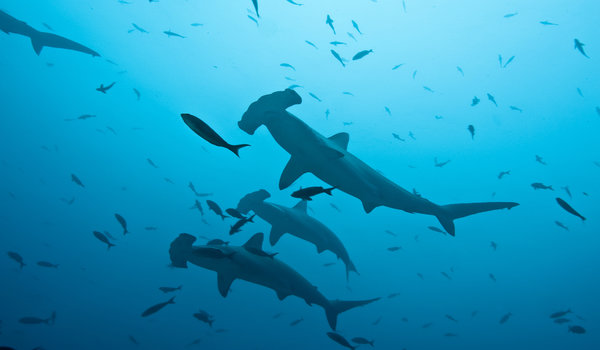When is the best time to dive with Hammerheads in Galapagos?
Do you want to dive with Hammerheads in Galapagos? Of course, you do! This article explains when the best time of year is to dive with hammerhead sharks in Galapagos and where to find them.

You can dive all year round with Hammerheads in Galapagos
Those who desire the large pelagic, the apex predators and the challenge of man against nature are a special type of diver. Divers of this type have one Mecca, the Galapagos Islands Archipelago. With strong currents, cold waters, and deep dives, not everyone is attracted to these islands.
Like everything in life, things are not always black and white. While diving conditions in Galapagos can be challenging, the truth of the matter is that most experienced divers will find that diving in Galapagos lies within their experience and comfort level. For Novice divers or less experienced open water divers, there are many “easy” dive sites to choose from that can be found around the inner islands. Gain more insight into when to go, what marine life you can expect and how to get there with our Galapagos Scuba Dive Guide.
That said; diving in Galapagos can be done by a novice and experienced divers who are looking for a challenge.
[the_ad_group id="1249"]When Is the best time to dive with Hammerhead sharks in Galapagos?
The remote Islands of Darwin and Wolf that are only accessible via a liveaboard are the best place within the Galapagos Islands to dive with the big schools of Hammerheads.
Each year around June hundreds if not thousands of Scalloped Hammerheads migrates to these islands in the north. Hammerheads feed best in groups, and it is not uncommon for divers to come across groups numbering more than 300 sharks. These slow moving “clouds” will cast a shadow on a dive site that will remind you of a solar eclipse. One minute it is daylight, the next night.
Scalloped Hammerheads are considered coastal pelagic species, which means they normally follow near the edge of the continental shelf. This allows them to dive deep (They are often found as deep as 1,000 feet) when they want and return to the shallows to eat.
Smooth Hammerheads and Great Hammerheads are also found in these waters but in much smaller numbers. A large number of sharks stay around until November when some of them start to migrate. A sizable population of hammerheads does stay year-round in Galapagos.
Also read: 5 impressive sharks you will encounter when diving in Galapagos
Dive with Hammerheads at Gordon Rocks in Galapagos
At Gordon Rocks which lies about a 1 hr boat ride from Puerto Ayora, you can find the hammerheads year round. Gordon Rocks is an extinct volcanic crater with a sandy bottom at 32 meters, and a wall drop off around the outside of around 65 meters. It has 3 exposed rocks that surround the crater and 3 pinnacles ranging from 5- 6 meters under the surface along the northern edge of the crater with one larger pinnacle approximately 21 meters below the surface in the center.
Schools of up to 30 sharks (or more if you are lucky) can be found circling the rocks through the current giving repeated views of the amazing creatures. Though Gordon Rocks can be a calm and easy dive at times, it is famous for its currents that carry the hammerhead sharks. Therefore, it is best suited to advanced divers.
Also read: When is the best time to dive with Whale sharks in Galapagos?
Hammerheads are known to school only during the day
It is thought the schools may be used as a way to protect themselves from predators. However, it appears that the largest hammerheads are comfortable being on their own all the time while the medium-sized and smaller sharks group together.
Hammerheads also school as part of the mating process. The mating schools mostly consist of females, with the smaller females found along the edges of the school, while the largest and strongest are in the middle. The males focus on mating only with the females in the center of the school to ensure the strongest and the largest number of offspring.
When is the best time to dive with Hammerheads in Galapagos?
You can dive with Hammerhead sharks in Galapagos year round at Gordon Rocks which is almost always included in a landbased dive package. If you are planning a liveaboard dive trip to Galapagos to dive the around Wolf and Darwin Island you should plan your trip between June and November as you are likely to see big schools of hammerheads.
Would you like to dive with Hammerheads in Galapagos? We have multiple partners on Galapagos who offer dive packages + accommodation anywhere in the world or search the map for our Scuba Dive partners:
[the_ad_group id="1250"]Did you ever dive with Hammerhead sharks in Galapagos or anywhere else? Let us know in the comments below.
This article is written by RUSHKULT, the online booking platform for Scuba Diving. Visit the RUSHKULT platform to book your next Scuba Dive training, guided trip, and accommodation. [the_ad id="10253"]
Leave a Comment